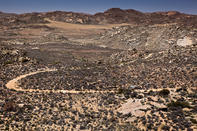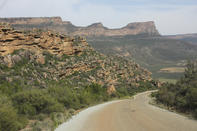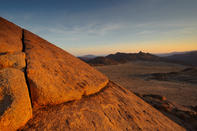Expeditions
In 1685, Governor Simon van der Stel set out with an expedition from the Castle in Cape Town into the dry northern regions, in search of the fabled Copper Mountains and the wealthy empire of Monomotapa. Between the Sandveld and Namaqualand, the expedition stopped over at a small cave with a nearby spring that was known to the Hottentots and Bushmen.

This stopover had been used three years previously when Van der Stel first sent a smaller expedition off to search for the copper and gold that Africa promised to yield. Olaf Bergh had then carved his name into the cave wall, and so began a tradition of graffiti that included many later travellers and dignitaries who passed that way. Thus the cave acquired its name of the 'Heerenlogement', meaning 'gentleman's lodging'.
Among the many names to be seen on the cave walls are that of the Swedish botanist Karl Thunberg (1724), the French explorer and naturalist Francois Le Vaillant (1783), the German botanist K. L. Zeyher (1829) and Andrew Geddes Bain (1854). While Olaf Bergh's party returned home after one of its members was killed by a lion near the Piketberg, Van der Stel reached the jumble of copper-coloured granite domes near present-day Springbok.
Although they sank three shafts, his party failed to retrieve any significant amount of copper ore, certainly not enough to compensate for the arduous journey over rugged land to Cape Town, the heat, lack of water and general hostility of the land.
Explorers
When Swedish naturalist Karl Thunberg travelled through the arid west of the Karoo, he spent much of his time in the Gifberg Mountains, above Vanrhynsdorp. On the well-watered summit plateau of these outliers of the Cape Fold mountains, he found the northernmost extension of the fynbos flora. He identified many fynbos species here, including the original and widespread sugarbush, Protea repens.
Thunberg called this plant mellifera, or honey bearing; it is much favoured by nectar-drinking creatures and has also long been used by rural people as a source of sweetener called 'bossiestroop' ('wild syrup', or, literally, 'little bush syrup').
The father of modern taxonomy, Linnaeus, had earlier given this plant a specific name meaning 'creeping' after being misled by an inaccurate illustration. North of Springbok and receding into a great loop made by the Orange River, is one of the most inaccessible and hostile areas on the subcontinent, rivalled only by the barren Namib Desert.
This is the Richtersveld mountain land, where even four-wheel-drive vehicles have short life spans. The jarring corrugations of its roads seem to be miniatures of the ranks of quartzite and granite mountains that turn the Richtersveld into a moonscape, similar to those burning, burnished and gnarled mountain lands of the Kaokoveld, the Swakop and Kuiseb canyons in Namibia.
The mountains here, such as the Rosyntjieberg with its maze of gullies and scars which give it the texture of a giant raisin, are, however, generally more prominent than those in Namibia. This place is filled with grandeur and pathos - the landscapes are certainly grand, but the plants, the animals and the small human settlements, such as Eksteenfontein, and the quaintly named Lekkersing, seem like pitiful flotsam in this unfriendly land. The valley floors are baked hard and the rough hillsides all but devoid of vegetation, other than a few weird, small plants.
The feeling of being the only person ever to see this remote area is common to those who manage to get there. The Karoo is a wonderland of succulent plants, and botanists have yet to identify them all. Some look exactly like the pebbles among which they grow. In the family Mesembryanthemaceae alone, of which this ruschia is a member, there are over 2 000 species.

